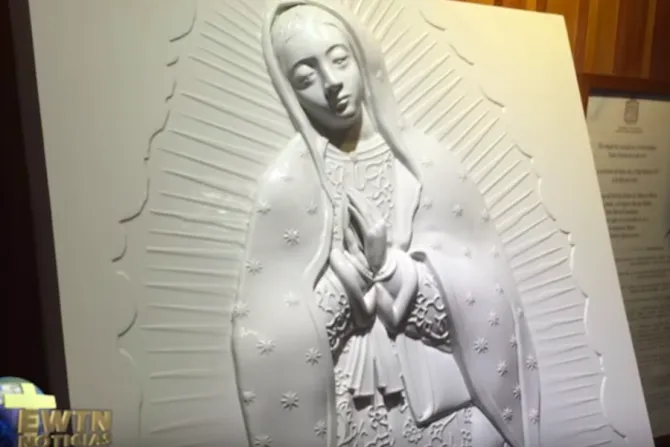Mexico City, Mexico, Dec 11, 2021 / 14:00 pm
Just inside the entrance to the Basilica of Our Lady of Guadalupe in Mexico City is a small area with a bas-relief sculpture of the Virgin Mary on display, designed especially for the blind to encounter Our Lady.
Fr. Umberto Mauro Marsich, an Italian Xavarian missionary priest, explained to ACI Prensa, CNA's Spanish language news partner, that the image is made of highly durable nylon fiber and is a gift from the Institute of Italian Culture and the Italian Embassy.
The sculpture is a “gift to the Archdiocese of Mexico so the blind can come here” and venerate Our Lady of Guadalupe, he said.
“They first read the entire description in Braille, the Nahuatl symbology of the image” on a panel to the side, “and then they come over and touch the image with their hands,” he explained.
Marsich, who holds a doctorate in moral theology and teaches at the Pontifical University of Mexico, played a key role in having the image of Our Lady of Guadalupe for the blind made and donated.
The idea came about in 2008 during an exposition of a painting of the Virgin de la Pera in Mexico which was brought to the country along with a much simpler bas-relief version.
The head of an association for the blind was in attendance at the exposition. When he touched the bas-relief image he said, “Why can't we do something similar with Our Lady of Guadalupe?”
Fr. Marsich, who was also there at the time, said he worked with two other Italians to have a bas-relief of Our Lady of Guadalupe made.
“My friend Faranda went back to Italy and looked for people to make donations” for the work of art, Marsich said.
The sculpture was produced in the city of Faenza, Italy, in 2009. It cost about $22,000 to make.
A few days after its completion, it was brought to Saint Peter's Basilica in the Vatican, where Pope Benedict XVI blessed it. It was then transported to Mexico and placed in the Guadalupe Basilica on Dec. 9, 2009.
More than 100 visually-impaired people gathered on the day the statue was installed in the basilica. Marsich said he was touched by their emotion, as, “finally being able to touch her, [they] discovered the beauty of the message conveyed to them by the Nahuatl symbology, which is a very luminous symbology.”
“People were so obviously moved that they were weeping,” he recalled.
However, the image is not just to be contemplated by visually impaired people, he pointed out.
The priest stressed that everyone can express “in some way our affection, our love, our tenderness for Mary, the Virgin of Guadalupe.”
Marsich hopes other bishops will be encouraged to ask for a replica of the image of the Virgin Mary for their dioceses, which he said would cost significantly less than the original.
(Story continues below)
This article was originally published on CNA on Dec 12, 2019.



